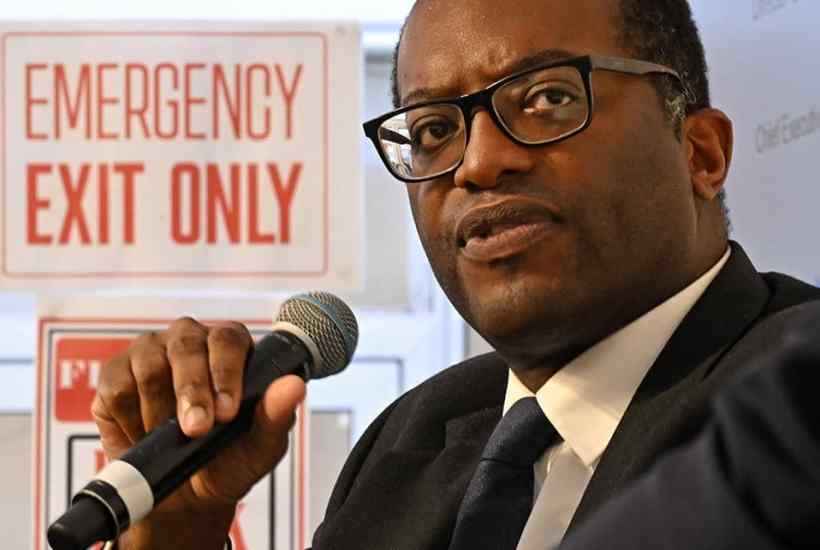Warren Buffett famously said that ‘when the tide goes out, you see who is swimming naked’. Now that the tide of easy money has receded, and interest rates have risen, we can see that the UK is exposed. Higher rates are causing acute financial pain to an extent not anticipated for the government, homeowners and even pension funds. The cost to the taxpayer is going to be significant.
The Bank of England is in an almost impossible position: it needs high interest rates to tackle inflation, but high rates threaten financial stability. Which is the lesser evil? The Bank has had to intervene in the gilt markets three times since Kwasi Kwarteng’s ‘fiscal statement’, in an attempt to lower rates and calm things down. Once bailouts start, how to stop? Andrew Bailey, the governor, has warned that pension funds have ‘three days’ left. Was he bluffing? If his bluff is called, what happens to his credibility?
We are now realising the jaw-dropping cost of this market chaos. Even before the latest market moves, the likely UK debt interest bill had nudged over £100 billion – twice what the Office for Budget Responsibility (OBR) forecast only in March. Even if inflation subsides, the government is going to end up spending £18 billion a year more than expected on debt interest. For reference, that’s more than the Home Office budget.
The higher debt interest bills are extraordinarily politically painful because they buy nothing: no new police officers, doctors or hospitals. Yes, much of this would have happened anyway as global rates rise. But the negative reaction to the mini-Budget is, according to the Institute for Fiscal Studies, responsible for £10 billion of that rise.
The government is desperately trying to reassure the markets. It has abandoned the abolition of the 45p tax rate and has appointed James Bowler, a Treasury man, to succeed the sacked Sir Tom Scholar as permanent secretary rather than the outsider Antonia Romeo. It has brought forward its next ‘fiscal event’ from 23 November to 31 October. The hope is that by making the announcement before the Bank of England meets to set interest rates on 3 November, the size of the coming interest rate rise can be limited.
The task facing the government on 31 October is extremely difficult. How to reassure the markets without spooking the public (or Tory MPs)? How to reassure the markets on borrowing without seeming to backtrack on the Trussite mission?
Trussonomics was based on the idea that tax cuts and reform would boost the growth rate of the economy and that the markets would happily fund that transition. The markets have not gone along with this plan. But what about the growth? The main verdict on this will come from the OBR – and even those closest to Truss don’t think it will raise its growth forecasts significantly on the back of the government’s actions. The OBR simply doesn’t share Truss’s optimism about how quickly supply side reforms will take effect.
If Truss has borrowed as much as is prudent for tax cuts – and perhaps more – and economic growth is still not revised upwards (indeed, some City firms have revised it downwards), then what will the Tories have to say at the next election? If Trussonomics is pronounced dead on arrival, then many in the City think that the government will have to abandon some more tax cuts – perhaps Truss and Kwarteng’s cancellation of the corporation tax rise.
The only alternative is spending cuts. But it is very hard to find enough politically deliverable cuts, given the extent to which departmental budgets are being eaten into by inflation. For example, the NHS’s chief financial officer warned last week of a £21 billion shortfall. If it is not filled, he said, the NHS would have to ‘completely revisit investment in cancer and mental health, primary care, the increase in diagnostic capacity, and you would have to look at what it meant in total for what the NHS could deliver’. And that’s without any extra cuts.
If Kwarteng cannot find savings elsewhere, he has no choice but to go back to the markets. This move risks another clash, which the government can’t afford.
The government was taking a big gamble in declaring that ‘growth, growth, growth’ was its message. Only this week, Capital Economics said its new forecast was not for growth but ‘a recession involving a peak-to-trough contraction in GDP of 2 per cent’. How would the Prime Minister reconcile this with her target of 2.5 per cent growth? What would a 2024 election campaign look like if her target wasn’t met?
Everyone is now imagining the future under a Labour government. The polls make it possible, even probable, that Starmer will be prime minister. The Tories can announce what they like, but businesses won’t make decisions on the basis of new policies until they have a better idea of whether those policies would be maintained by Labour. Investment zones, for example, are a good idea, but why would anyone make long-term plans based around them if they are likely to be ditched in 18 months?
David Cameron and George Osborne talked relentlessly about austerity. The reality of their policy was, in many ways, less severe than the rhetoric. But their willingness to make the political argument for spending restraint and to take difficult decisions meant that they commanded market confidence, which in turn meant that they had to cut less than they otherwise would have done.
Truss and Kwarteng are in danger of ending up in the opposite situation. They may have to keep going further to try to avoid startling an already sceptical market. The Halloween fiscal event will be a defining moment for this government.
Got something to add? Join the discussion and comment below.
Get 10 issues for just $10
Subscribe to The Spectator Australia today for the next 10 magazine issues, plus full online access, for just $10.
You might disagree with half of it, but you’ll enjoy reading all of it. Try your first month for free, then just $2 a week for the remainder of your first year.















Comments
Don't miss out
Join the conversation with other Spectator Australia readers. Subscribe to leave a comment.
SUBSCRIBEAlready a subscriber? Log in